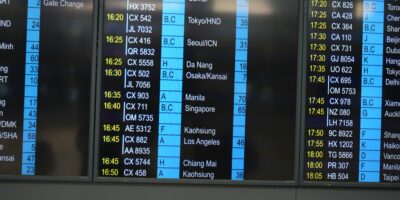Understanding the Las Vegas Airport Code
When planning a trip to Las Vegas, familiarity with the airport code will enhance your travel experience. The airport code for Las Vegas is LAS. This code represents McCarran International Airport, now officially named Harry Reid International Airport. Though renamed, the code remains the same—LAS.

Origin of the LAS Code
Every airport in the world has a unique three-letter code assigned by the International Air Transport Association (IATA). These codes help identify airports in flight schedules, luggage tags, and airline tickets. LAS comes from the city it serves, Las Vegas.
McCarran International was officially opened in 1948, and its code, LAS, was designated around this time. The historical aspect plays a role in the continuity of the airport’s code, as changing it could lead to confusion among passengers and logistical complications for airlines.
Location and Infrastructure
LAS is situated about five miles south of downtown Las Vegas. It occupies roughly 2,800 acres of land, making it a significant hub for domestic and international travel. The airport has a layout designed to handle large volumes of travelers efficiently. There are two main passenger terminals: Terminal 1 and Terminal 3. Each terminal serves distinct airlines and routes.
- Terminal 1: Houses four concourses with gates A-D. Most Southwest Airlines flights depart from here.
- Terminal 3: Primarily for international flights and long-haul domestic routes, with gates E through G.
The airport offers a range of services and amenities, including dining options, shopping, and lounges. Ground transportation is readily available—taxis, shuttle services, and public buses make commuting convenient.
Flight Operations and Statistics
LAS is one of the busiest airports in the United States. In 2019, it ranked in the top 10 for passenger traffic. While these numbers dipped due to the pandemic, recovery efforts have reestablished its position as a crucial travel hub.
The airport operates under continuous pressure to accommodate the city’s thriving tourism industry. Regular flights connect LAS to major cities across the US and worldwide, with heavyweights like American, Delta, and United maintaining a significant presence.
Security and Innovations
Airports are ever-evolving, and LAS is no exception. Security remains a top priority. The Transportation Security Administration (TSA) implements rigorous checks to ensure passenger safety. Efficient security protocols streamline passenger experience while maintaining vigilance.
LAS has embraced technological advancements. From automated security lanes to self-service kiosks, these initiatives aim to reduce waiting times and enhance passenger experience. LAS was among the first airports to introduce biometric boarding, where passengers use facial recognition instead of boarding passes.
Environmental Considerations
Like many other airports, LAS is committed to minimizing its environmental footprint. An array of solar panels provides renewable energy, aiming for sustainability. Additionally, the airport has implemented water conservation strategies due to the region’s arid climate.
Initiatives like waste reduction and recycling programs further contribute to sustainability goals. LAS is also working on noise reduction measures, crucial in balancing operations with neighborhood peace.
Transportation and Accessibility
Accessibility is vital for an airport’s success, and LAS excels in transport connectivity. The RTC Transit operates bus routes directly linking the airport to different parts of the city, including The Strip and downtown Las Vegas.
Taxi and ride-sharing services provide stress-free alternatives for quick and direct travel. Rental car services at the MCC scale center cater to visitors planning road trips beyond the city.
Inside the Las Vegas Airport
The LAS infrastructure is designed for traveler comfort. The terminals reflect Las Vegas’s vibrant spirit, with colorful slot machines dotting the airport’s waiting areas. Art installations throughout the airport provide cultural enrichment for travelers.
Piercing the landscape are vibrant displays that mirror the glitz of the Las Vegas Strip. Multiple charging stations ensure passengers stay connected, and Wi-Fi is free, accommodating travelers’ digital needs.
Food and Shopping
Las Vegas supports its reputation as a culinary destination within LAS. Dining options cater to all tastes and time constraints. From fast food chains and coffee shops like Starbucks to full-service restaurants offering diverse cuisines, the choices are abundant.
The shopping selection is equally varied. Duty-free stores offer tax advantages to international travelers, while specialty shops cater to diverse interests. Last-minute souvenirs are easy to find, whether trinkets or high-end gear.
Cultural Touches and Art at LAS
Within the airport, you’ll discover elements that reflect Las Vegas’s rich culture. Art installations and exhibitions occasionally change, featuring works by local artists. This initiative not only beautifies the space but also supports the local art scene.
Seasonal events or performances might greet you as you navigate the terminals, offering a small taste of the entertainment Las Vegas is known for.
Future Prospects and Expansion
LAS continues to expand and evolve to meet future demands. Projects focus on improving infrastructure and technology to handle increasing passenger numbers. Future terminal expansions are under consideration, alongside transportation upgrades for improved efficiency.
The airport is also exploring the integration of more sustainable practices and technologies, signaling its commitment to environmental responsibility.
Conclusion
LAS stands as a gateway to one of the world’s most dynamic cities. Its unique blend of efficiency, technology, and vibrancy ensures it ranks among the best travel experiences. As it continues to grow and innovate, LAS will likely maintain its status as a top choice for travelers worldwide.
Recommended Aviation Gear
David Clark H10-13.4 Aviation Headset – $376.95
The industry standard for aviation headsets.
Pilots Handbook of Aeronautical Knowledge – $25.42
Essential FAA handbook for every pilot.
As an Amazon Associate, we earn from qualifying purchases.




Subscribe for Updates
Get the latest articles delivered to your inbox.
We respect your privacy. Unsubscribe anytime.